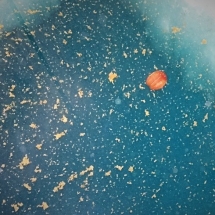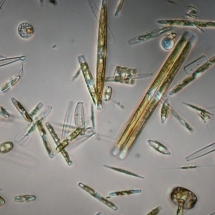Aggregates
During the green edge 2016 experiment, at the beginning of June, we observed an aggregate event : A morning the hole used for water column sampling was full of millions of large organic particles : aggregates. The same situation repeats every day during a full week before disappearing completely.
Organic aggregates are composed of microscopic algae that stick together with an organic glue mainly excreted by diatoms, these beautiful microscopic algae that have the particularly to build a silica (glass) shell, named frustule.
Aggregates are the main component of the marine biological pump. Meaning that they transport some of the atmospheric carbon dioxide, transformed in organic carbon by the biological activity, at depth where it is trapped for centuries. They also are an excellent food for the herbivorous. For all these reasons, aggregates are a very interesting research object. Aggregates are generally formed during phytoplankton bloom.
However, at this time of the year, we observe only ice algae, and no pelagic bloom near Qikiqtarjuaq. These aggregates were transported by the strong tide current and concentrated in all holes that we made in the ice, the one used for water sampling, and all those made for incubation experiments or ice coring. We don’t know for sure the origin of these aggregates but we postulated that they are made from ice algae that started to detach from the ice and collide together due to current. Indeed, those aggregates were composed by the same diatoms that we observed in the ice -a majority of pennate diatoms. By contrast in the water column, we can observe a good proportion of centric diatoms.
The photosynthetic capacity of the diatoms was very high showing that they were very nutritive because they were made of healthy cells. However, they were also sinking very quickly when they were not anymore transported by the current. Aggregates formed by ice algae when the ice starts to melt probably provoke the massive sinking of the diatoms grown during the spring at the interface between the ice and the seawater. This is confirmed by the increase of the Chla values, the main photosynthetic pigment of healthy cells. In the sediment traps placed under the ice to sample the sinking particles, Chla increases by a factor as high as 20 during the days following the observation of aggregate event.
Morgane Gallinari


